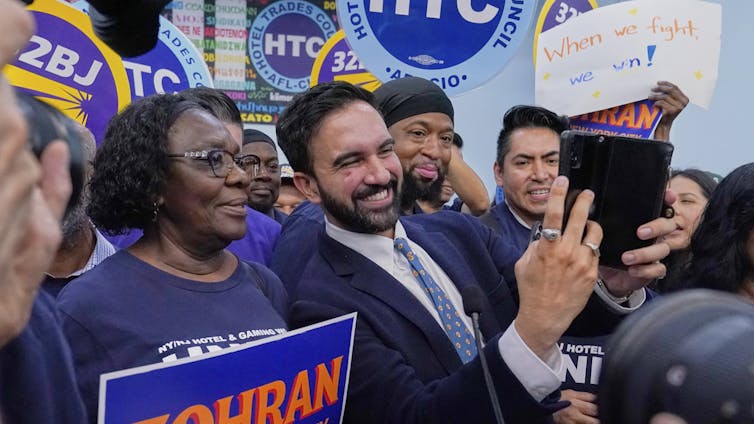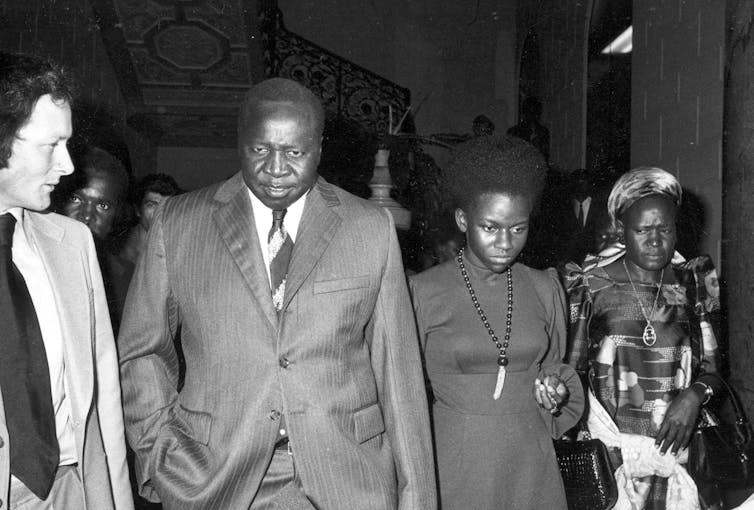

When Zohran Mamdani introduced his candidacy for mayor of New York Metropolis, political observers famous his progressive platform and legislative report. However understanding the Democratic candidate’s background requires analyzing the wealthy cultural tapestry woven into his very surname: Mamdani.
He takes the title from his father, Mahmood Mamdani, a distinguished tutorial who was raised in Uganda and whose work focuses on postcolonial Uganda. I studied the historical past of the Khoja group for my doctoral work and have helped develop Khoja research as a tutorial self-discipline. The Mamdani surname tells a narrative of migration, resilience and community-building that spans centuries and continents.
The Khoja historical past
Mamdanis in Uganda belong to the Khoja group, a South Asian Muslim service provider caste, that formed financial improvement throughout the western Indian Ocean for hundreds of years.
The title originates from higher Sindh, a area in South Asia that at the moment contains southeastern Pakistan and Kachchh in western India.
Its etymology is twofold. Mām is an honorific title in Kachchhi and Gujarati languages, that means kindness, braveness and satisfaction. Māmadō is an area model of the title Muhammad that always appeared in surnames in Hindu castes that transformed to Islam, such because the Memons.
The Khoja had been categorized by the British within the early nineteenth century as “Hindoo Mussalman” as a result of their traditions spanned each religions.
Over time, the Khoja got here to be recognized solely as Muslim after which primarily as Shiite Muslim. At this time, nearly all of Khoja are Ismaili: a department of Shiite Islam that follows the Aga Khan as their residing imam.
The Mamdani household, nonetheless, is a part of the Twelver group of Khoja, whose Twelfth Imam is believed to be hidden from the world and solely emerges in instances of disaster. Twelvers consider he’ll assist usher in an age of peace throughout finish instances.
Across the late 18th century, the Khoja helped export textiles, manufactured items, spices and gems from the Indian subcontinent to Arabia and East Africa. Via this Western Indian Ocean buying and selling community, they imported timber, ivory, minerals and cloves, amongst different items.
Khoja household corporations had been constructed on kinship networks and belief. They constructed networks of retailers, communal housing and warehouses, and prolonged credit score for hundreds of miles, from Zanzibar in Tanzania to Bombay – now Mumbai – on the western coast of India.
Cousins and brothers would ship cash and items throughout the ocean with solely a letter. The precarious nature of commerce on this interval meant that households additionally served as insurance coverage for one another. In instances of wealth, it was shared; in instances of catastrophe, assist was accessible.
Khoja contributions in Africa
The Khoja grew to become instrumental in constructing the business infrastructure of jap, central and southern Africa. However the Khoja contribution to the event of Africa prolonged far past commerce.
Within the absence of colonial funding in public infrastructure, they helped construct establishments that fashioned the muse of the trendy nation-states that emerged after colonization. The establishments each facilitated commerce and established everlasting communities.
For instance, the primary dispensary and public college in Zanzibar had been constructed by a Khoja magnate, Tharia Topan, who made his wealth via the ivory and clove trades. Topan finally grew to become so distinguished that he was knighted by Queen Victoria in 1890 for his service to the British Empire in serving to to finish slavery in East Africa.
The Khoja group continues to put money into East Africa. Probably the most well-known instance is the Aga Khan Growth Community, whose hospitals and faculties function in 30 international locations. In locations similar to Kenya, Uganda and Tanzania, they’re thought of the very best.
Khoja in Uganda
Like in different components of Africa, the Khoja settled in Uganda as a liaison enterprise group to develop a market to serve each African and European wants. The linguistic and cultural information, developed over centuries, helped facilitate enterprise regardless of the challenges of colonization.

Nevertheless, in 1972, Ugandan dictator Idi Amin expelled all Asians – roughly 80,000 – forcing households just like the Mamdanis into exile. These included indentured laborers, who had been introduced in to assist construct the railroad and farm in the course of the British colonial interval, and free merchants, just like the Mamdani household.
Amin noticed all of them as the identical and famously mentioned: “Asians got here to Uganda to construct the railway. The railway is completed. They have to go away now.”
The expertise was a bitter one. Households misplaced the whole lot, and lots of left with solely the garments on their backs.
Mahmood Mamdani, who got here from a Khoja service provider household, was 26 when he was exiled. But, in contrast to most Ugandan Asians, he selected to return. At Makerere College in Kampala, Uganda’s capital, Mamdani arrange the Institute for Social Analysis, which helped to supply rigorous social science coaching to Ugandan researchers making an attempt to enhance their society.
Whereas the sooner generations of the Khoja tended to decide on enterprise or adjoining professions, similar to accounting, the next generations – notably these educated within the West – embraced the information financial system as professionals, teachers and nonprofit leaders.
A number of of Mahmood Mamdani’s era of Khoja teachers performed path-breaking work on Afro-Asian solidarity – a mind-set in regards to the world past colonial classes, such because the class of faith as a separate area from the secular. These students, similar to Tanzania’s Issa Shivji and Abdul Sheriff, labored on creating solidarity among the many newly unbiased states of the World South.
Mahmood Mamdani is understood for his influential post-9/11 tutorial work, “Good Muslim, Unhealthy Muslim,” which examined how Muslim identities are stereotyped. He argued that these identities are complicated and diversified, formed by gathered historical past and current experiences.
Interfaith id
The Khoja group – identified globally because the Khoja Shia Ithnasheri Muslim Neighborhood – has developed sturdy transnational connections. At this time, they’re concentrated in the UK, Canada, United States and France. Nevertheless, Khoja might be present in virtually any nation on the earth. In 2013, I met members of the group in Hong Kong.
The Khoja group performs an necessary position in interfaith dialogue and international improvement initiatives. A distinguished Ismaili Khoja, Eboo Patel, the founding father of Interfaith America, has devoted his life to pluralism and mutual understanding via build up civil society.
Zohran Mamdani’s mom, acclaimed filmmaker Mira Nair, is Hindu by delivery. This interfaith marriage exemplifies the pliability, variety and tolerance of Khoja Islam, which has traditionally navigated between Hindu and Islamic traditions.
Whether or not Mamdani’s insurance policies show sensible stays to be seen, however his background affords one thing useful: a deep understanding of how communities construct resilience throughout generations and geographies.
Iqbal Akhtar, Affiliate Professor of Spiritual Research, Florida Worldwide College
This text is republished from The Dialog beneath a Inventive Commons license. Learn the unique article.
![]()
SEE ALSO:





